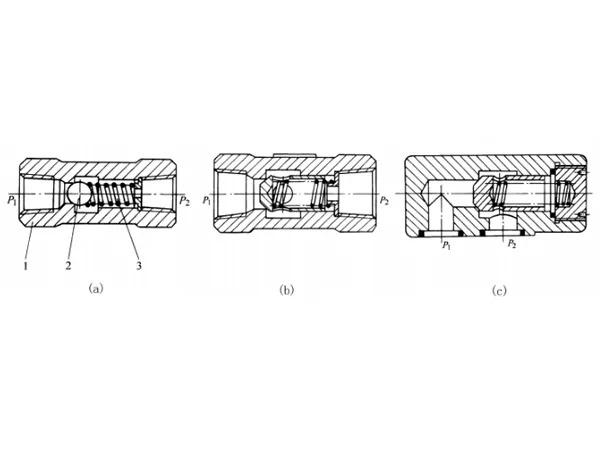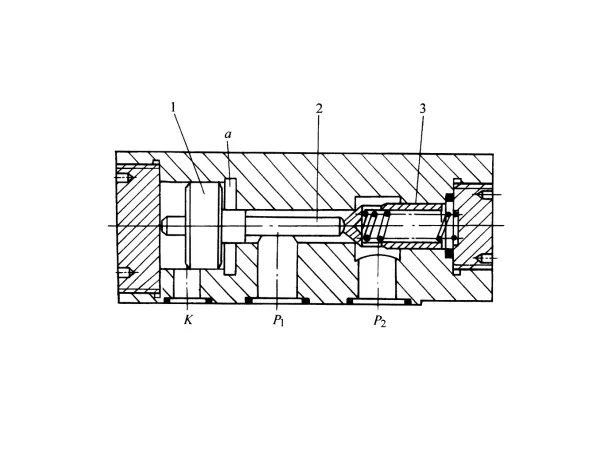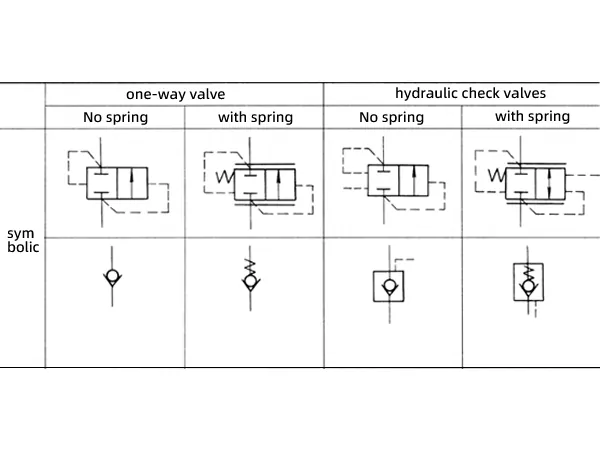Understand Check Valves: Optimize Your Hydraulic System
Check valves are Directional Control Valves that ensure that the liquid flow through the valve flows in one direction only and cannot flow in the opposite direction, and are generally composed of parts such as the valve body, spool, and spring.
Structure
Valve body: the main component, connected to the pipeline.
Valve flap: a moving part controlled by a spring to open or close the flow channel.
Spring: used to ensure that the valve flap is in the absence of fluid pressure in the closed state.
Seal: ensures a tight seal between the valve flap and the valve body to prevent leakage.

When the pressure oil flows into the valve from the inlet port P1, it opens spool 2 and flows out through the outlet port P2. When the flow is reversed, under the action of spring 3 and pressure oil, the spool is pressed on valve body 1, cutting off the channel so that the oil can not pass. According to the use of Check Valves, the requirements of the oil through the positive resistance to small, liquid flow has a reverse flow trend, the closing action to be sensitive, closed after the seal to be good. Therefore, the spring is usually very soft, the opening pressure is generally only 3.5 × 104 ~ 5.0 × 104Pa, mainly used to overcome friction.
Check valve spool is divided into steel ball type (a) and cone type (b), (c) two kinds. Steel ball type spool simple structure, low price, but poor sealing, generally only used in low pressure, small flow Hydraulic System. Cone-type spool resistance is small, has good sealing, long service life, so it is more widely used, mostly used in high-pressure, high-flow hydraulic systems.
Check valve connection is divided into tube connection (a), (b), and plate connection (c) two kinds. Pipe connection check valve, its inlet, and outlet made of pipe threads, directly connected with the pipeline connector; plate connection check valve, its inlet, and outlet for the orifice with a flat bottom countersinking cylindrical holes, screwed to the base plate. The flat bottom countersinks are placed in the O-shaped sealing ring seal, the base plate, and pipeline connectors using threaded connections. Other types of control valves also have two types of pipe connection and plate connection structure. In the hydraulic transmission system, sometimes needs to be blocked by the check valve oil re-connection, this can be made into a check valve blocking direction that can control the structure, this is the hydraulic check valve.

When the control port K does not control the pressure oil, the oil can only enter from inlet P1, open spool 3, out of outlet P2, and can not flow in the opposite direction. When the control oil from the control port K into the control pressure oil, the left end of piston 1 by the action of oil pressure moves to the right (the right end of the piston oil chamber a and the drain port, the figure is not drawn), through the top rod 2 will be open to the right of the spool valve, so that the inlet P1 and the outlet P2 connected, the oil can be free to flow in both directions. Minimum oil pressure for control
The minimum oil pressure for control is about 0.3 to 0.4 times the pressure of the main oil circuit of the hydraulic transmission system.

In hydraulic and pneumatic systems, the symbol for a check valve is typically represented by an arrow indicating the flow direction, often accompanied by a shape representing the valve disc. Commonly used symbols include:
Check Valve: An arrow and a line, with the arrow pointing in the allowed flow direction.
These symbols are used in technical drawings and circuit diagrams for ease of design and maintenance.
Conclusion
Check valves are essential components in hydraulic systems, ensuring unidirectional flow and preventing backflow. Their design and operation are crucial for the efficient and safe functioning of hydraulic machinery.
Why Choose SAIVS™ as Your Supplier?
With 20 years of industry experience, SAIVS is a leading Chinese manufacturer of high-quality tools, offering competitive pricing and excellent customer service.We pride ourselves on exceptional quality control, extensive experience, and comprehensive after-sales service.